General Dynamics F-16 Fighting Falcon operators
The United States Air Force (USAF), four of its NATO partners, and Pakistan, a major non-NATO ally, are the primary operators of General Dynamics F-16 Fighting Falcon. With the evolution of sales under Foreign Military Sales (FMS) contracts, many other air forces have also acquired F-16s. Most nations that have bought F-16s continue to use them as of 2010.
| General Dynamics F-16 Fighting Falcon operators | |
|---|---|
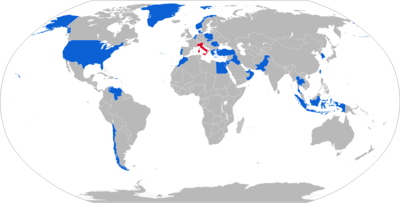 | |
| Map with F-16 operators in blue and former operators in red |
The F-16 is still in demand today, and many air forces are looking to replace aging inventories with F-16s. Because the USAF has steadily upgraded its F-16 inventory, it will sometimes sell older aircraft it considers obsolete as surplus Excess Defense Articles (EDAs) or as "knockdown" aircraft to supplement spares inventories.
United States operators

Several commands of the United States Air Force (USAF) as well as the United States Navy (USN) and National Aeronautics and Space Administration (NASA) use various models of the F-16 Fighting Falcon.
United States Air Force
The USAF operates 1,245 F-16s with 701 with active forces, 490 with Air National Guard and 54 with Reserve. These are broken down to 1 F-16A Block 15, 197 F-16C/D Block 25, 350 F-16C/D Block 30, 51 F-16C/D Block 32, 222 F-16C/D Block 40, 174 F-16C/D Block 42, 198 F-16C/D Block 50, 52 F-16C/D Block 52.[1]
Air Combat Command
Air Combat Command (ACC) is the descendant of the merger of the Tactical Air Command (TAC) and Strategic Air Command (SAC). ACC is the primary combat aircraft operator of the United States Air Force. Originally, all new F-16s would be delivered to TAC or ACC and then transferred to other commands, but now aircraft are often delivered directly to the other commands.
- 20th Fighter Wing - Shaw AFB, South Carolina
- 53d Wing - Eglin AFB, Florida
- 85th Test and Evaluation Squadron
- 422d Test and Evaluation Squadron, Nellis AFB, Nevada
- 57th Wing - Nellis AFB, Nevada
Air Education and Training Command
The Air Education and Training Command (AETC) provides for most of the US Air Force's F-16 training facilities and operations. The command also provides for training of foreign air forces operating the F-16, with two squadrons providing training for Singapore and Taiwan.
- 54th Fighter Group (GSU) - Holloman Air Force Base
- 8th Fighter Squadron
- 54th Operations Support Squadron
- 54th Training Squadron
- 311th Fighter Squadron
- 314th Fighter Squadron
- 56th Fighter Wing - Luke AFB, Arizona
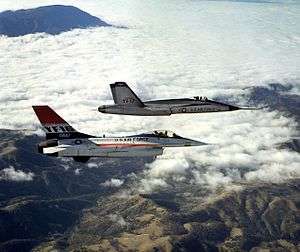
The descendant of the merger of the Air Force Systems Command (AFSC) and the Air Force Logistics Command (AFLC), Air Force Materiel Command is responsible for providing, testing, and maintaining US Air Force equipment. As such, it plays a large part in the F-16 program, both in testing the aircraft and its weapon systems. It utilizes the F-16 for numerous tests for weapons equipping many US Air Force aircraft. Additionally, it operates overhaul programs to maintain the F-16 fleet of not only the US Air Force, but several foreign air forces as well.
Air Force Reserve Command
The delivery of the F-16 to the Air Force Reserve Command (AFRC) marked the first aircraft type to be delivered new, changing the long policy of merely passing older airframes on from the active forces to the Air Force Reserve. AFRC currently operates Block 25, 30, and 32 aircraft.
- 301st Fighter Wing - NAS JRB Fort Worth, Texas
- 482d Fighter Wing - Homestead JARB, Florida
- 93d Fighter Squadron
- 944th Fighter Wing - Luke AFB, Arizona
Air National Guard
As with the Air Force Reserve, the F-16 marked the transition of the Air National Guard (ANG) to a viable fighting force complementary to active-duty units, as opposed to the second-line force of out-of-date aircraft it had been. The F-16 remains a key part of the ANG force structure.
|
|
Pacific Air Forces
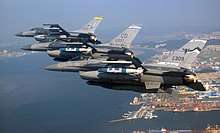
Pacific Air Forces (PACAF) was an early recipient of the F-16 and PACAF operates the latest models of the F-16 today.
US Air Forces in Europe
Once PACAF began receiving its F-16, US Air Forces in Europe (USAFE) became a recipient of the F-16. USAFE F-16s have been common participants in most recent US military operations in Europe and the Middle East.
- 31st Fighter Wing - Aviano AB, Italy
- 52d Fighter Wing - Spangdahlem AB, Germany
United States Navy
While the United States Navy chose the competing McDonnell Douglas F/A-18 Hornet for development as a carrier-based strike fighter, the service still had a need for an aggressor aircraft to supplement the Douglas A-4 Skyhawk and Northrop F-5E Tiger II aircraft posing as enemy fighters to help train Navy pilots in dissimilar air combat training (DACT). The lightweight F-16 was ideal for the job, and the F-16N version was specifically developed for the task. With removal of the internal cannon (compensated by ballast), the F-16N and two-seat TF-16N served for a number of years before retirement. The F-16 was reintroduced to the aggressor role for the US Navy with the acquisition of some of the Pakistani F-16A/B-15OCU aircraft embargoed before delivery to that country and they remain in use today at the Naval Strike and Air Warfare Center (NSAWC) at NAS Fallon, Nevada. The US Navy operates 40 F-16s.[2]
National Aeronautics and Space Administration
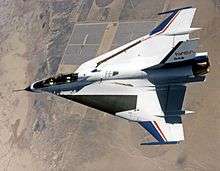
Though not a military force, NASA plays a vital role in research and development of aerospace technology. Its fleet contains two exotic F-16 models (bailed from USAF), the F-16XL and F-16A AFTI, both involved in researching advanced technologies for application to not only the F-16, but other aircraft as well. Additionally, a number of standard F-16s have been operated by NASA as chase aircraft and engine testbeds.
Original NATO partners
Once selected by the United States, it was further decided to form a partnership between the United States Air Force, then beginning development of the plane for service, and nations of the NATO alliance who had a similar need for a lightweight fighter. Four such nations chose to join the development effort, and became part as well of the production and sub-contracting work to build the Fighting Falcon. The four European partners, collectively known as the European Participating Governments (EPG), are Belgium, Denmark, the Netherlands, and Norway; their air forces are likewise referred to as the European Participating Air Forces (EPAF).
 Belgium
Belgium.jpg) Denmark
Denmark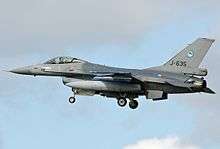 Netherlands
Netherlands_F-16AM_Fighting_Falcon_(401)%2C_Norway_-_Air_Force_AN0636300.jpg) Norway
Norway
Belgium
Belgium was the largest initial buyer of the F-16 of the four original NATO partners, and Belgium's aeronautical company SABCA was a primary producer of the aircraft as part of the partnership. Belgium's initial order brought delivery of 116 F-16A/B aircraft in blocks 1, 5, 10, and 15, beginning in 1979, and was completed in 1985. A follow-on order for 44 F-16A/B-15OCU aircraft was completed in 1991. Most of the Danish F-16s were also manufactured in Belgium. Many of the Belgian and Danish F-16s received the MLU update at SABCA.
Denmark
Denmark was the smallest member of the NATO partnership, with the Royal Danish Air Force accepting 58 F-16A/B aircraft under Denmark's initial order. A small follow-on order brought a further twelve aircraft to Denmark, and two further attrition replacement orders were later placed, resulting in a total of 62 F-16AM and 16 F-16BM that entered Danish service.[3]
Netherlands
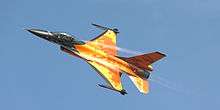
The Netherlands, like Belgium, made substantial orders for the F-16, and built aircraft at the Fokker plant. Deliveries started in 1979 and ended in 1992. A total of 102 aircraft were initially ordered, but these were followed by substantial follow-on orders for a total of 111 additional aircraft. 52 of these were F-16A/B-15OCU aircraft. These orders brought total Dutch F-16A/B deliveries to 213. 108 of them received the Mid-Life-Update (MLU).
Norway
Norway joined the original NATO-USAF partnership to replace its ageing Lockheed F-104 Starfighter squadrons. In 1975, Norway placed an order for 72 F-16A/B aircraft, delivered between 1980 and 1984. Unlike the other partners, there have been no follow-up orders, except for a single order in 1989 for two F-16B-15OCU aircraft as replacements for crashed aircraft. All the aircraft have received the Mid-Life-Update (MLU), and they received the new, helmet-mounted sighting system.
Europe
Greece
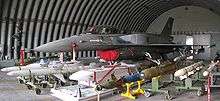
After protracted negotiations the Hellenic Air Force ordered the F-16 in 1985. FMS program PEACE XENIA was begun with delivery of 40 F-16C/D Block 30 aircraft in 1989 and 1990. This was followed by an order for 40 F-16C/D Block 50 fighters, delivered in 1997 and 1998. In June 2000 a further order for 50 F-16C/D Block 52+ aircraft was made with an option of 10 more fighters, exercised in September 2001. All 60 aircraft (40 C-model aircraft and 20 missionized D-model) were delivered by June 2004. In December 2005 the Greek government signed an LOA for the delivery of 30 additional F-16C/D Block 52M with a not exercised option on 10 more. The latest batch consists of 20 C-models and 10 D-models, while deliveries were completed in 2009. On 28 April 2018, Greece decided to upgrade 85 of its F-16 to the F-16V standard.[4]
Units:
- 330 Squadron Thunderbolt F-16C/D Block 30
- 335 Squadron Tiger F-16C/D Block 52+ Advanced
- 337 Squadron Ghost F-16C/D Block 52+
- 340 Squadron Fox F-16C/D Block 52+
- 341 Squadron Arrow F-16C/D Block 50
- 343 Squadron Star F-16C/D Block 52+
- 347 Squadron Perseus F-16C/D Block 50
Italy
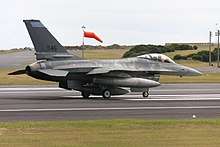
Italy has decided on the Eurofighter Typhoon as its next generation of air-defense fighter, however this aircraft faced delivery delays for some time. In the meantime, 24 Panavia Tornado ADV jets from the United Kingdom were leased to cover the gap. This lease ran out in 2003, without the Typhoon being ready for service. The solution was provided by a five-year lease of 34 F-16 aircraft with an option to extend the lease for another five years. 30 aircraft were F-16A/B-15ADF while the remaining four aircraft were earlier block aircraft for spares. These were all used U.S. Air Force fighters.
In June 2010, the Italian Air Force started the return of the F-16s to the United States which was completed on 23 May 2012, when all the Italian F-16 were returned to the USA.[5]
The Italian Foreign Military Sales program was known as PEACE CAESAR.
Poland
.jpg)
One of the former members of the Warsaw Pact that was looking to replace an aging fleet of Soviet-built Mikoyan-Gurevich MiG-23 (withdrawn in service in 1999 due to their small numbers and uneconomical operation) and the Mikoyan-Gurevich MiG-21 fighters (withdrawn from service in 2003), Poland conducted a competition between the Mirage 2000-5 Mk.2, the JAS 39 Gripen, the Mikoyan-Gurevich MiG-29 (the last offer was withdrawn), and the F-16 Fighting Falcon. Despite a strong challenge by the BAe/SAAB team, Poland purchased 48 F-16C/D-52+ aircraft. The aircraft were delivered from 2006 under the PEACE SKY program, to avoid confusion with the PZL W-3 Sokół (Polish language "Falcon") helicopter, these jet fighters were nicknamed the F-16 Jastrząb (Goshawk) in Polish. Now, the F-16, along with 32 Mikoyan-Gurevich MiG-29 fighters and 48 Sukhoi Su-22 ground attack aircraft are the main offensive strike force for Polish Air Force.
There were problems with the introduction of the Polish F-16s and they were often grounded with faults, they were given an unofficial nickname "nielot" (a flightless bird).[6][7]
There have also been delays in the offset program, the United States has not made all the promised investments in Poland that were part of the deal. Offset deals in 2011 reached $6 billion out of $6.028 billion planned ($9.8 billion at time when offer was chosen), however only one-third of recognised offsets commitment were direct investments in Polish economy.[8][9]
According to a former Polish military defence vice-minister, the offer for JAS 39 Gripen was a better deal.[10] F-16s cost $3.5 billion, compared to 3.2 billion euro for Saab's Gripen, and 3.6 billion euro for Dassault offer,[11] at a time when both currencies had a similar value.
Portugal
The Portuguese Air Force chose the F-16 during the 1980s to replace its aging and obsolescent LTV A-7 Corsair II attack aircraft which were no longer suitable for air-to-air combat and were facing severe logistical problems.[12][13][14]
The Portuguese Foreign Military Sales program is known as Peace Atlantis.
Peace Atlantis I
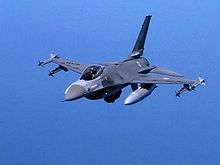
In August 1990 the government of then-Prime Minister Aníbal Cavaco Silva signed a Letter Of Acceptance (LoA) which lead to the creation of the Peace Atlantis I program. The funds used for the purchase were made available through the Foreign Military Sales program, partly a payment for the use by the United States of Lajes Air Base in the Azores. Initially the United States proposed to supply Portugal with Block 10 surplus aircraft. However this option rested on a first order of 20 newly built F-16 Block 15 OCU (17 A-models and three B-models) with Pratt & Whitney F100 engines, which made them almost identical to the US Air National Guard's F-16 ADF. Deliveries of this first order began on February 18, 1994, and was completed on July 18 in the same year.
The initial group of Portuguese F-16 pilots was constituted by fighter pilots from the 302 and 304 Squadrons, received training in Tucson, Arizona, between January and June 1994.
During the War in Kosovo, it was seen that while the Portuguese F-16s were recently obtained, they were no longer up to the same level as most modern fighters used by other NATO countries. In 1999, during the Portuguese participation in the conflict (Operation Allied Force), the three F-16 fighters deployed by Portugal were relegated to escort missions and combat air patrols due to their lack of modern armament and air-to-ground targeting systems.
Peace Atlantis II
During 1996, during the government of then-Prime Minister António Guterres, new negotiations took place concerning the possible purchase of new of F-16 fighters and the modernization those aircraft. The Pentagon approved of the deal on November 20, 1997, and on November 30, 1998, Portugal signed the Letter of Offer and Acceptance (LoA) for 25 second-hand F - 16 Block 15 (21 A and four B) that had been used by the U.S. Air National Guard. Under the program these would be offered by the United States at zero cost and free of charge as Excess Defense Articles under the Southern Regional Amendment to the Arms Export and Control Act, with Portugal being responsible for their transportation to Europe and for the modernization costs.
Included in the LoA and in the Peace Atlantis II program was also the purchase of new Pratt & Whitney F100-PW-220E engines, 20 upgrade kits, logistics support and training.
Initially, the plan consisted in only upgrading the second-hand aircraft of the Peace Atlantis II program and of transferring the F-16s from the Peace Atlantis I to a second squadron with the mission of performing tactical air support actions and tactical air support for maritime operations (TASMO), which wouldn't require the MLU kit.
Of the second-hand F-16s, five of the airframes were used as spare parts, and only the remaining 20 F-16s were intended for upgrade for day & night all-weather operations, by receiving the Falcon UP structural upgrade, the F100-PW-220E engine upgrade and the Mid-Life update (MLU) avionics and cockpit upgrade, to equip the 301 Squadron.
Current status
The Mid-Life upgrade (MLU) was performed in Portugal by the Air Force's workshops at Monte Real and by OGMA in Alverca. In 2001, employees of the LMTAS modified the first two aircraft in a Lead-the-Fleet program, with Portuguese technicians observing. The first F-16 AM was delivered in June 2003, and the PoAF personnel performed the modification of the remaining 18 aircraft.
Currently the Portuguese F-16 fleet uses the AN/ALQ-131 ECM pods, that had originally been bought for the A-7P Corsair IIs, and the new Rafael LITENING II targeting pods. One aircraft has been preserved for public display and two aircraft have been lost in accidents.[15]
In 2006 the Portuguese government put 12 F-16 for sale.[12] On September 25, 2012, Romania and Portugal started negotiations for the sale of 12 used F-16s from Portugal in a deal worth $600 million. Aircraft are to be delivered to Romania over the next five years.[16][17][18][19] On October 11, 2013, the Romanian National Defense Ministry announced the signing of the contract for the purchase of 12 used F16.[20] After the sale the Portuguese fleet will consist of 30 F-16 planes. To enable this, 3 ex-USAF F-16s (2 x F-16AM and 1 x F-16BM) were delivered in 2019.[21]
| Operating units | Model | Location |
|---|---|---|
| 201 Squadron "Falcões" | F-16 AM F-16 BM | Air Base No. 5, Monte Real |
| 301 Squadron "Jaguares" |
Romania
On 24 March 2010, Romania's Supreme Defense Council approved the purchase of 24 refurbished F-16C/D Block 25 aircraft from the U.S. Air Force inventory. The first batch of aircraft was scheduled to arrive in 2013. Total cost for the aircraft was estimated at US$1.4 billion.[22] Romania failed to pay the first installment on the aircraft, even though it was delayed from 3 June to 3 August.[23]
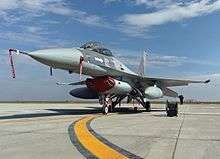
On 27 September 2012, Romania's Supreme Defense Council approved a plan to buy 12 used F-16s from Portugal in a deal worth 670 million euros. The aircraft will be delivered over the next five years and will enter operational service in 2016 after pilot training.[24] Romania was to complete negotiations and finalization of documents with Portugal by the end of May, and with the U.S. by September. 120 million euros will pay for the aircraft, with the rest paying for logistic support. The 12 F-16s will replace 48 MiG-21s in Romanian service.[25] Legislation regarding the F-16 deal was passed by the country's Chamber of Deputies in June 2013 and on 12 July 2013, Romanian President Traian Băsescu formally approved the purchase.[26] On 11 October 2013, Romania completed the purchase of 12 Lockheed Martin F-16 Fighting Falcons with MLU package from Portugal.[27] The package is worth $252.6 million/186.2 million euros, and includes nine former Portuguese Air Force aircraft and three former U.S. Air Force aircraft supplied to Portugal for the resale under the U.S. Excess Defense Article program. Nine aircraft are single-seat and three are twin-seat. Portugal will receive 78 million euros for the sale, and the rest will be spent acquiring and upgrading the U.S. surplus aircraft and associated equipment. The first F-16 is scheduled to be delivered in 2016 with initial operational capability achieved in 2017.[28]
The Romanian Armed Forces intend to buy 12 more Lockheed Martin F-16AM/BM Fighting Falcons by 2020 to equip a second squadron. After that, the Romanian Air Force plans to buy 24 F-16s of a newer generation by 2025, probably Block 50s.[29]
On 27 September 2016, the first six F-16 MLUs entered service within the Romanian Air force. The ceremony took place in Portugal at the 5th Airbase Monte Real.[30] The First F-16 Squadron will enter active service in the 53rd Fighter Squadron at the 86th Airbase in Fetesti.[31]
In March 2019, the Romanian Ministry of Defence launched the procedure to procure an additional 36 F-16 aircraft.[32]
In April 2019, the Romanian Ministry of Defence announced the Romanian Air Force would procure an additional five F-16s from Portugal, potentially receiving them before the end of the year.[33][34]
Slovakia
Slovakia had been looking to replace its aging fleet of MiG-29s since at least 2014, when an option of leasing Swedish Saab JAS 39 Gripen fighters was considered. A possible proposal was finalized in December 2015. However, by June 2016, the deal was rejected due to concerns over cost. Following this, a new round of negotiations was opened.[35] In February 2018, it was reported that Slovakia was in talks to buy either the F-16 or the Gripen fighter jets.[36] In April 2018, the Slovak Ministry of Defence received an offer for F-16 fighters, amounting to $2.91 billion, from the US Department of Defense.[37] On July 11, 2018, the Government of Slovakia approved the purchase of 14 F-16 Block 70/72 fighters for 1.589 billion euros ($1.86 billion).[38]
In November 2018, the Slovak Ministry of Defence announced it had placed an order for 14 F-16V aircraft for €1.6 billion.[39] Soon after however, the country's Prime Minister went on record to say the contracts were "invalid", stating the documents had not been approved by the Ministry of Finance.[40] It was rapidly revealed that the inability of the ministries to cooperate was due to political rivalries, and the F-16 purchase had caused a minor political crisis in Slovakia.[41] On 12 December 2018, the contract deal to acquire 12 single-seat and 2 double-seat F16 Block 70/72 was officially signed by Slovakian Minister of Defense Peter Gajdos. The first aircraft to arrive into service are scheduled as soon as 2022.[42][43]
Turkey
The Turkish Air Force is the world's third largest operator of the F-16, following the US and Israel. Turkey became one of the nations to indigenously produce the F-16, under a license from Lockheed Martin. Turkey initially received in total 240 F-16s. However, a further 30 were ordered in 2007. All Turkish F-16s are built by Turkish Aerospace Industries (TAI). Each new aircraft had to visit American territory under the terms of the PEACE ONYX Foreign Military Sales program before being turned over to the Turkish Air Force. In 2005, Turkey signed a $1.1 billion avionics upgrade package, based on the USAF's Common Configuration Implementation Program (CCIP). In addition to this, the Turkish Air Force put a firm order for 30 more F-16 Block 50+, to be built by TAI.[44] As of 2016, all existing F16s are now in Block 50+ 'Viper' configuration. On 24 March 2019, the Turkish State Secretariat for Defence officially confirmed that a further upgrade with ASELSAN for the modernisation of THK's entire F-16 fleet with a domestic AESA radar and a new indigenous EW-self-protection suite by 2021.[45]
Middle East
Bahrain
The small country of Bahrain originally ordered the F-16 in 1987, agreeing to buy eight Block 40 F-16Cs and four F-16Ds under the PEACE CROWN program. These aircraft arrived prior to the first Persian Gulf War. After this, with the increasing military presence of the United States, Bahrain sought further enhancement of its air force and the replacement of its F-5 Tiger II fighters. Initial talks centered on the F-16N being withdrawn from service with the U.S. Navy and U.S. Marine Corps, but ultimately, it was decided to purchase ten new Block 40 F-16C aircraft. Bahrain ordered an additional 16 F-16 Block 70s in November 2017.[46]
Egypt
Since the historic Camp David accords, Egypt has actively sought to re-equip its military with western weapons. Thus, it has become a large customer for the F-16 Fighting Falcon, which fits well with Egyptian defense needs. No fewer than six separate PEACE VECTOR programs have delivered 42 F-16A/B-15, 40 F-16C/D-32, and 138 F-16C/D-40 fighters to the Egyptian Air Force by 2002.[47] In March 2010 it was announced that Egypt would purchase an additional 20 Block 52 aircraft (16 F-16Cs and 4 F-16Ds).[48] The Egyptian Air Force operated 220 F-16s at that point, making it the world's 4th largest F-16 operator.[49] 4 of the F-16s ordered were delivered on 3 February 2013, raising the number of aircraft delivered to 224. The remaining 16 will be delivered through 2013.[50] Following the 2013 Egyptian coup d'état, the Pentagon had said deliveries of the jets would continue. On 24 July 2013 however, President Barack Obama announced the F-16 deliveries would be halted due to continuing political unrest.[51] In March, 2015 the US announced the resumption of the deliveries of the F-16s, the last of which was delivered in October, 2015.[52][53]
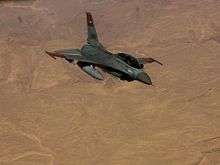
Israel

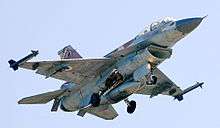
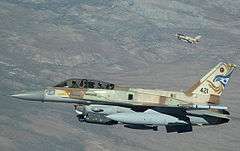
The Israeli Air Force (IAF) is the second largest user of the F-16 Fighting Falcon, second only to the U.S. Air Force and its reserve components. The IAF achieved the type's first air-to-air victories when IAF pilots shot down two aircraft, a Mi-8 helicopter and a MiG-21 Fishbed fighter plane, both Syrian, in April and July 1981.[54]
The IAF took delivery of its first F-16s earlier than expected after the cancellation of the sale of F-16s to the Iranian Air Force. The IAF had announced plans to buy 75 F-16s as early as 1978, and deliveries were carried out under American Foreign Military Sales program Peace Marble I. These F-16As and Bs received the nickname Hebrew "Netz" (Hawk). Peace Marble II witnessed the delivery of a further 75 block 30 F-16Cs and F-16Ds to the IAF. Israel's F-16 fleet was further expanded by Peace Marble III, which brought 30 block-40 F-16Cs and 30 two-seat F-16Ds to the IAF between 1991 and 1993. These newer models were nicknamed "Barak" ("lightning"). In part to reward Israel for its restraint during the Gulf War, a shipment of 50 US-surplus F-16As and F-16Bs were delivered in 1994.
In a deal worth $4.5 billion, Israel also ordered 102 additional block 52+ F-16Ds, designated the F-16I nicknamed "Sufa" (Storm). Deliveries of these took place between 2004 and 2009.[55]
In July 2013, Israel began a program called Teuza (boldness) for the purpose of turning some military bases into sales lots for obsolete IDF equipment. Older models that are not suited for Israel's modern high-tech forces will be sold off, or sold for scrap if there are no buyers. Old-model F-16 jets are among those being offered. Main buyers are expected from Latin American, Asian, and African countries.[56] Later that month, Major General Amir Eshel ordered the immediate shutdown of two squadrons of F-16A/B fighters, without any advance warning to the squadrons' air and ground crews. The shutdown was because of military cuts and the mission capability of one F-16I compared to several older models. The aging F-16A/Bs were planned to be decommissioned in 2017 with the arrival of the F-35 Lightning II Joint Strike Fighter. The decision was made to advance the retirement of the aging platforms. One F-16A/B squadron continued to serve as an advanced jet trainer unit until the deliveries of Alenia Aermacchi M-346 Master aircraft began in 2014.[57] The final F-16A/B aircraft were retired on 26 Dec 2016.[58]
Iraq
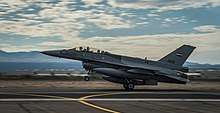
The Iraqi Air Force was looking to buy 36 F-16s for its air force in late 2008 in place of phased-out Russian and Chinese fighters during Saddam Hussein's regime acquired before and during the Iran–Iraq War.[59][60] In the spring of 2009, the decision was made to spend $1.5 billion on an initial order of 18 F-16 fighters. Later purchases could bring the total buy to 96.[61] The first set was to be delivered by 2014, with all 36 currently ordered delivered by 2018.[62]
The first F-16IQ Block 52 fighter was delivered to Iraq on 5 June 2014, making it the 28th country to receive the F-16. The fighter was the first of six two-seat D-models. F-16IQs can be armed with AIM-9L/M Sidewinder and AIM-7 Sparrow air-to-air missiles, AGM-65 Maverick air-to-ground missiles, and Paveway guided bombs.[63] Due to advances made by Islamic State militants in mid-2014 which forced the evacuation of contractors from Balad Air Base, Iraqi F-16s were sent to Tucson, Arizona, where Iraqi pilots trained on their aircraft.[64] 4 F-16 IQs were delivered to Balad Air Base on 13 July 2015. The last F-16 was delivered to the Iraq airforce on November 14, 2017.
Jordan
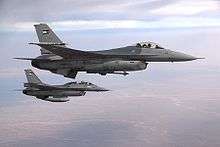
Like Egypt, Jordan opened the door to modern American arms sales by reaching a peace agreement with Israel, this one in 1994. Jordan then arranged for a lease of air defense F-16s from the United States, and to transfer ownership eventually. The program was successful, providing Jordan with 16 F-16A/B ADF fighters in 1997 and 1998 under Peace Falcon I program, RJAF recognized the need to give these aircraft a mid-life update (MLU) in the next 2 or 3 years. (2 F-16A Block 15 ADF aircraft crashed over the years of service).[65] A second Peace Falcon II program delivered a further 17 aircraft of similar type. All of the 17 F-16A/B upgraded by TAI to F-16AM/BM MLU standard. In 2005, Jordan purchased 16 F-16AM/BM Peace Falcon III from Belgium.[66] Later the Royal Jordanian Air Force (RJAF) pursued more second hand purchases in 2006 6 F-16BM Peace Falcon IV purchased from RNLAF,[67] An additional 9 F-16AM/BM Peace Falcon V delivered in July/Aug 2011 from Belgium,[65] the purchase totaled 31 aircraft, putting the RJAF in a good position with 62 F-16s.
Peace Falcon I
On July 29, 1996, a $220 million agreement was signed between the United States and Jordan authorizing the lease of 16 F-16 fighter jets (12 F-16A and 4 F-16B aircraft) to Jordan. This agreement, formally signed by Field Marshal Marei, chief of staff of the Royal Jordanian Armed Forces and Major General Ababneh, chief of staff of the Royal Jordanian Air Force, was linked to the Middle East peace process and close US-Jordanian relations. The complete material/training support agreement, known as the F-16 Peace Falcon Program, includes funding for aircraft structural upgrades, engine modifications, support equipment and spare parts procurement, and pilot/maintenance training.
The agreement consisted of two lease contracts and a Letter of Offer and Acceptance (LoA). The first lease was a no-cost lease for Jordan, covering 13 aircraft (12 A models and 1 B model, block 15 OCUs that were modified into ADF (Air Defense Fighters) versions. Under the Arms Export Control Act, the DOD was able to provide these aircraft at a no-cost lease because they had flown off over 75 percent of their life (i.e. more than 3,000 hour). Three of the B-model aircraft still had more than 25 percent of their life left and they fall under the second $4.5 million lease. Both leases cover a 5-year period. The LOA is for $215 million, covering all costs associated with upgrading those aircraft, doing the structural modifications to them, the engine upgrades, providing the support equipment, the logistics, the training.
The aircraft, all of which have flown previously by active Air Force and Air National Guard units, had been in storage for at least a year at the Aerospace Maintenance and Regeneration Center (AMARC) at Davis-Monthan AFB, Tucson, Arizona before they were shipped to Hill AFB, Utah. There the Aircraft Directorate personnel from the Ogden Air Logistics Center performed structural upgrades to extend aircraft life from the designed 4,000 to 8,000 hours flying time as part of the Falcon-Up/Service Life Improvement program. They also modified the aircraft engine bay to accept the upgraded Pratt and Whitney F100-220E engine. New ground was broken with this Foreign military Sales program: taking 'used' F-16s from the desert (AMARC), completely refurbishing and modifying them and delivering the aircraft to the customer within a 17-month time frame.
On October 14, 1997 Lt. Col. Scott Curtis, flying safety officer at Hill AFB, pushed the throttles forward and released the brakes on his F-16 Fighting Falcon aircraft. Within a matter of seconds the aircraft accelerated to 140 knots and the first Jordanian F-16 (tail number #80-0547) was airborne. It took more than 13,000 man-hours to get this F-16 ready for its first flight. The #80-0547 had not flown since November 1994, when it was flown from the ANG Station in Garden City, N.J. to the Aerospace Maintenance and Regeneration Center, Davis-Monthan, Arizona. The official roll-out of the Peace Falcon was on October 28, 1997, on Hill AFB, Utah.
The Jordan program required that six aircraft be available for ferry flight delivery to Jordan in December 1997, and five each to be available for ferry flight in January and February 1998. At that time, the RJAF planned to acquire as much as 60-70 F-16s (if possible C/D models), enough to equip 3 squadrons.
Peace Falcon II
There have been talks about a second batch of 16 refurbished F-16s, which would have been delivered under the Peace Falcon II program. After initial talks in 1999, no further news has become available about this program. The RJAF is still looking for a replacement for its obsolete F-5 fighters which are due within a couple of years. They are in favor of acquiring another batch of F-16s for this replacement.
On January 29, 2003, numerous sources indicated that Jordan received 6 F-16 fighters that day in a ceremony held at Shahid Muafaq Al-Satlti AFB. This ceremony was attended by prince Faisal bin Hussain and US ambassador Jordan Edward W. Gnehm. The US embassy in Amman stated that these 6 aircraft were the first of a batch of another 17 (12 F-16As and 5 F-16Bs) that would be delivered to Jordan during the year 2003. All these aircraft are former US ANG F-16 ADFs. These aircraft are to be upgraded with the MLU modification (See Modifications and Armament).
Ultimately, 16 A-models and 1 B-model was delivered to the RJAF. Most of those airframes were put into storage waiting for their MLU conversion. In 2008 these modifications were in full swing at the TUSAS facility in Ankara, Turkey. By 2009 all of those modified airframes will be delivered back to Jordan for operational use.
Peace Falcon III
In 2005 the RJAF contacted the Dutch and Belgian governments for a batch of F-16s. In April 2006 representatives of both air forces flew to Amman to sign a Letter of Intent for the acquisition of up to 22 ex-Dutch (8 airframes) and ex-Belgian (14 airframes) F-16s. The lot would consist of 17 A-models and 5 B-models (Netherlands: 5 A-models, 3 B-models; Belgium: 12 A-models, 2 B-models). All these aircraft have undergone the MLU upgrade which gives the Jordanians a serious boost in air power and also a sneak preview of the possibilities they will gain after their entire fleet is upgraded with this package. The aircraft are due to be delivered in 2007–2008.
In 2009 a total of 16 Belgian F-16s (12 As and 4 Bs) were delivered, but the Dutch order for A-models was canceled. By that time it became apparent that only the 3 B-models of the first purchase from the Netherlands and the 3 B-models included in the second purchase would be handed over to Jordan during 2009 as part of Peace Falcon IV.
Peace Falcon IV
The Dutch Secretary of Defence announced at the Dubai Air Show in November 2005 that he had signed a Letter of Intent for the purchase of 3 F-16Bs by the RJAF. The aircraft were to be used as training assets and are due for delivery in 2006.
In the end, the number of F-16BMs was raised to 6. The delivery of those was postponed until the summer of 2009.
Peace Falcon V
In 2009 the Belgian government decided to put another 9 F-16AMs for sale. The first country to respond was Jordan and negotiations have been ongoing till 2011. Finally the delivery consisted of 6 F-16AMs and 3 F-16BMs, all delivered in July 2011. The number of Jordanian F-16s rises to 64 airframes with this delivery.
On 24 December 2014, a Jordanian F-16 crashed in Syria after being allegedly shot down by ISIS. The pilot, First Lieutenant Mu'ath Safi Yousef al-Kasasbeh, was captured by ISIS militants.[68][69] On 3 February 2015, a video posted on ISIS-linked Jihadi websites, showed al-Kasasbeh being burned alive.[70]
Oman
In May 2002, the Sultanate of Oman signed an agreement with the U.S. government to purchase 12 Advanced Block 50 F-16s in the PEACE A'SAMA A'SAFIYA ("Clear Skies") Foreign Military Sales (FMS) program. The agreement includes eight single-seat F-16Cs and four two-seat F-16Ds.[71] On 23 August 2010 Peace A'sama A'safiya II contract was signed which saw a further ten F-16C and two F-16Ds delivered in 2014.[72]
United Arab Emirates
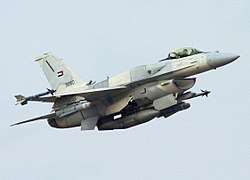
The United Arab Emirates operates the newer F-16 variants, the F-16 Block 60 F-16E (single seat) and F-16F (two seat), unofficially called the F-16 Desert Falcon.[73] The aircraft has been developed especially for the United Arab Emirates Air Force (UAEAF) and features improved AN/APG-80 active electronically scanned array (AESA) radar, avionics, conformal fuel tanks (CFTs), and the more powerful General Electric F110-GE-132 engine.[74][75] The United Arab Emirates invested in its development and generate royalty payment for operators buying it.[73]
Africa
Morocco
The Bush administration announced plans to sell Morocco 24 F-16C/D fighters and 24 T-6B trainers aircraft valued at up to $2.6 billion on 27 December 2007.[76] The sale was officially announced on 6 June 2008[77] and deliveries commenced in July 2011.[78] All F-16s were delivered by the end of August 2012.[79]
On March 25, 2019 - The U.S government has approved the sale of 25 new F-16 Block 72s and related equipment for an estimated cost of $3.787 billion to Morocco [80] as well as an upgrade package to bring the existing 23 F-16 Block 50/52+ up to the very similar F-16V standard plus the related equipment for an estimated cost of $985.2 million.[81]
Asia
Indonesia
The Indonesian Air Force operates a mix of F-16A/B Block 15 OCU and F-16C/D Block 32+ (locally promoted as Block 52ID). In 1989, Indonesia received a single allotment of 8 F-16A and 4 F-16Bs. Two F-16s were lost in accidents leaving the fleet with only ten F-16s.[82] A purchase of nine more aircraft was cancelled in favor of 12 Su-30KI, however this order was later also cancelled due to the Asian Financial Crisis.[83][84] The Indonesian Air Force was planning to upgrade their F-16A and B aircraft to F-16C/D variants by the end of 2009, and there was an option of purchasing new F-16C/Ds to replace their retired, but in reserve, F-5E Tiger IIs.[85] From 2000 to 2005 the US imposed an arms embargo on Indonesia which resulted in the F-16 squadron being grounded due to a lack of spare parts. The US lifted the arms embargo in 2005 and the US has since delivered 24 refurbished F-16 fighters to add to nine older models.[86] The total estimated cost was $750 million, and that included an upgrade to near Block 52 standard.[87][88] With the retirement of their F-5 Tiger II airplanes, the Indonesian Air Force was seeking additional airplane types well suited for air defense role. In February 2018 Indonesia signed a purchase contract to buy eleven Sukhoi Su-35 fighters in a US$1.1 billion deal.[89] Lockheed Martin was offering F-16V Viper as a cheaper alternative than the Russian planes. Indonesia is currently upgrading their F-16A/B under the "EMLU-Falcon STAR" project. Indonesian Air Force will purchase 32 F-16V Block 70/72 in 2020-2024 for MEF (Minimum Essential Force) Phase III program.[90][91][92][93][94]
Pakistan
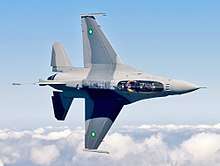
Pakistan was an early customer of the F-16, seeking to counter a heavy Soviet presence in Afghanistan, in addition to countering its traditional rival, India. An initial order for 40 aircraft was delivered in two installments, and led to a further order for 71 more F-16A/B-15OCU aircraft. Due to political developments relating to Pakistan's nuclear program, these aircraft were embargoed before delivery. 28 aircraft remained in storage while other buyers were sought (and a 10 year lease to the Royal New Zealand Air Force fell through) due to a change in government, but ultimately it was decided that the aircraft would be put into service with the US Air Force and Navy as aggressor aircraft. The remaining aircraft on order had work stopped before completion.
The Pakistani Foreign Military Sales program is known as PEACE GATE.
In November 2006, the Pakistan Air Force signed a Letter of Acceptance (LOA) for 18 new-built F-16C/D Block 52, 28 F-16A/B Block 15 and 60 Mid-Life-Update M3 Tape modules/kits as part of a $5.1bn deal including fighter aircraft, their related infrastructure, training and ammunition. Deliveries of the F-16A/Bs are expected to begin in 2007, while the initial F-16C/Ds will likely be received sometime in late 2008 or early 2009. The current procurement program of new-built aircraft as well as refurbishment and upgrade of 60 used and serving aircraft is expected to be complete by 2010–2012, as per the Pakistan Air Force Air Chief Marshal Tanvir Mahmood Ahmed. In April 2006, Janes Defence Weekly reported that the PAF may procure an additional 18 Block 52 from the current deal. In July 2007, Commander of Central Command Air Forces, Lieutenant General Gary L. North (U.S. Air Force), and another U.S. aviator flew a pair of F-16s to Pakistan for Pakistan Air Force.[95]
In December 2009 the first F-16/D block 52 rolled out for PAF. First batch arrived in Pakistan in May 2010, 17 F-16C/D were delivered to PAF by the end of December 2010.[96] One F-16D used for testing joined PAF in 2012 along with two examples upgraded to MLU in USA.[97]
In April 2014, the PAF received a batch of five F-16s it had bought used from Jordan. The total order is for 13 aircraft.[98]
Singapore
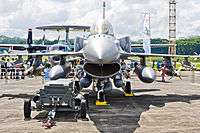
The Republic of Singapore Air Force began as a small F-16 user, but has a steadily growing fleet. It has operated the aircraft since 1988, when the first of its initial order for 8 F-16A/B-15OCU arrived. Since then, it has begun ordering multiple installments of F-16C/D Block 52/52+ aircraft, totalling 74 of the advanced fighters. Ongoing upgrade to Block 70/72 Super Viper.
The Singapore Foreign Military Sales program is known as PEACE CARVIN.
Units:
- Air Combat Command (ACC)
- Fighter Group (FG)
- 140 Squadron Osprey F-16 C/D
- 143 Squadron Phoenix F-16 C/D
- 145 Squadron Hornet F-16 D+
- Fighter Group (FG)
South Korea
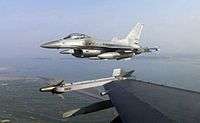
Facing a desperate need for advanced aircraft to counter North Korea's numerical superiority, Republic of Korea Air Force was quick to order the F-16 to meet its needs with a 1981 order for 36 F-16C/D Block 32 aircraft (later 4 F-16Ds added by profit from exchange rate fluctuation), making it the first operator for the C/D model outside of the United States. A more ambitious program (Korean Fighter Program) to provide 120 new fighters was initially lost to the F/A-18 Hornet, but various difficulties led to the order going to the F-16C/D Block 52D (KF-16C/D), 72 of which were to be manufactured in South Korea, 36 of which were to be delivered in kit form and assembled in South Korea, and 12 of which were to be produced in Fort Worth, U.S.A.. In 2000, a further 20 Korean-built F-16s were added.[99]
The South Korean Foreign Military Sales program is known as PEACE BRIDGE.
In May 2009, South Korean government announced upgrade plan for its KF-16C/D fleet's radar and armament, as part of the 2010-2014 arms acquisition and management package being submitted to President Lee Myung-bak for approval. The ROKAF operates about 135 of the “KF-16” fighters, many of which were built in Korea under a $5.5 billion licensing agreement from 1994 to 2004. Key upgrades will include new radars to replace the existing APG-68v5/v7 systems, avionics and computers, and improving cabling and databuses to MIL-STD-1760 so that the aircraft will be able to carry GPS-guided weapons, AIM-9X Sidewider missiles, and other new equipment.
In March 2014, the South Korean Air Force revealed that it was considering leasing F-16s operated by the U.S. Air Force. ROKAF F-4 and F-5 fighters were intended to be replaced through the F-X III competition by 2016 and the development of the KF-X indigenous fighter, but F-X III deliveries were delayed until 2018 and the KF-X won't enter service until 2023. With the aging fighters still needing to be retired, between 20 and 60 American F-16s are being reviewed for leasing to sustain aircraft numbers. South Korea had previously leased U.S. T-38 Talon trainers for over a decade until the completion of the KAI T-50 Golden Eagle, but a country leasing a combat fighter is very rare due to risk of increased costs if they need to be used in a conflict situation.[100]
Taiwan
.jpg)
Taiwan is a major F-16 customer, although it has placed only a single order for the aircraft. In 1992, 150 F-16A/B-20 aircraft were ordered while at the same time Taiwan ordered 60 Dassault Mirage 2000 and launched its own indigenous fighter program, the AIDC Ching-Kuo. Delivery of all F-16s was completed in 2001.
Taiwan's foreign military sales program is known as PEACE FENGHUANG (Peace Phoenix).
The Republic of China Air Force (ROCAF), needing a next generation fighter to replace its fleet of F-5s, has expressed interest in the new F-35 Lightning II. However, due to political issues, it is unlikely it will be able to acquire such an advanced fighter in the near future. As a result, the ROCAF has opted for up to 66 new F-16C/D Block50/52 as its interim replacement fighter.[101] As with all military purchases, Beijing has expressed opposition to the sale.[102] However Obama agreed to a $5.3 billion deal to upgrade Taiwan's current fleet of F-16 A/B Block 20s to configuration similar to that of the proposed F-16V standard with AESA radars.[103] Upgrades for the first four fighters will be completed in 2018, with all fighters upgraded by 2023.[104] In 2019, Taiwan received its first F-16V.[105]
In August 2019, the Trump administration approved the sale of up to 66 new F-16 Block 70 worth up to $8 billion to Taiwan.[106][107]
Thailand
The Royal Thai Air Force initially considered a candidate to purchase the F-16/79. Thailand's first order was ultimately for 12 F-16A/B-15OCU fighters, immediately bolstered by a further 6 F-16A-15OCU planes. 18 more aircraft were received in 1995, the last new-production block 15 aircraft built. An attempt to buy F/A-18 Hornets failed, and in place of them, the US offered to sell USAF F-16ADFs Excess Defense Articles. A total of 18 examples were bought. In early 2005, the Royal Thai Air Force received 3 F-16A-15OCU and 4 F-16B-15OCU from the Republic of Singapore Air Force. The Thai Foreign Military Sales program is known as PEACE NARESUAN.
In 2011, 18 F-16A/B-15 OCU from 403 Sqd. will be upgraded to F-16 MLU.
Latin America
Chile
The Chilean Air Force selected the F-16 as the winner of a long-running competition to provide the nation's next generation of fighter aircraft in 2000. The F-16 competed successfully against the JAS 39 Gripen, the Dassault Mirage 2000, and the F-18 Hornet. Chile has already received all of its ten F-16C/D Block 50+ aircraft. The deal for six C and four D model aircraft was valued at $600 million in 2002 and was conducted under the program name PEACE PUMA. Eighteen surplus F-16A/B MLU aircraft (11 F-16AM and 7 F-16BM) were bought from the Netherlands in 2005, and were delivered by mid-2006.[108] In late 2008, the Chilean Ministry of Defense expressed its interest in buying 18 more aircraft from the Netherlands,[109] which was later confirmed in April 2009.[110]
The Chilean F-16 Block 50s can be armed with US missile such as the AIM-120 and AIM-9 Sidewinder, and Israeli made missiles Derby, Python IV and Python V.
The Air Force of Chile F-16s are part of the following units:
- 1st Air Brigade (I Brigada Aérea) in Los Condores Air Base.
- 3rd Aviation Group (Grupo de Aviación Nº 3).
- 5th Air Brigade (V Brigada Aérea) in Cerro Moreno Air Base.
- 7th Aviation Group (Grupo de Aviación Nº 7).
- 8th Aviation Group (Grupo de Aviación Nº 8).
Venezuela
_Lofting.jpg)
The first – and for a long time the only – Latin American user of the F-16, Venezuela ordered a total of 24 F-16A/B Block 15 aircraft in May 1982 under the PEACE DELTA program; the U.S. government originally offered the F-16/J79 version, but eventually authorized sale of the standard Block 15 version.[111] Deliveries of 18 ‘A’ models and 6 ‘B’ models began in September 1983 and were completed in 1985. Since entering operational service in 1984, these fighters have served with 161st and 162nd Fighter Squadron of Fighter Air Group 16 at El Libertador Airbase, Palo Negro. The Venezuelan Air Force had wanted to order a further batch of 24 aircraft, but was unable to afford the purchase.[112]
Venezuela has been seeking two attrition replacements for lost F-16s since late 1997,[113] but has not been able to obtain them due to financial problems and souring relations between the United States and the government of President Hugo Chávez. On 15 May 2006, the U.S. government announced that it would enact a ban on arms sales to Venezuela to become effective at the beginning of October of that year. This embargo was expected to soon render Venezuela's F-16 fleet non-operational, and General Alberto Muller, a military advisor to President Chávez, responded to the embargo announcement with a threat to sell Venezuela's remaining 21 F-16s to Iran.[114] Subsequently, the Chávez government decided to pursue replacement of its American-sourced military aircraft inventory with Russian aircraft, and in mid-June 2006 it was revealed that Venezuela had recently ordered several Sukhoi Su-30s.[115]
Venezuela's F-16s have been modified to use the Israeli Python IV IR-guided air-to-air missile.[116] They are also capable of carrying the Rafael LITENING II targeting pod.
| Operating Units | Model | Location |
|---|---|---|
| 16º Grupo Aéreo de Caza "Dragones" | El Libertador Airbase, Palo Negro | |
| F-16A/B Block 15 | El Libertador Airbase, Palo Negro | |
| F-16A/B Block 15 | El Libertador Airbase, Palo Negro | |
Future and potential operators
Bulgaria
It was reported in December 2012 that Bulgaria was going to negotiate buying 8 or 9 second-hand fighter jets. Among the contenders were the Swedish Gripen, second-hand Italian Eurofighters and second-hand Portuguese F-16s.[117] Later, in January 2013, it was reported that the Bulgarian Defense Ministry was expected to buy nine F-16s from Portugal.[118] The final phase of the initial preparations was to be started by the middle of 2013.[119] However, widespread protests led to the resignation of the Borisov cabinet, which delayed all government plans and activities.
A new round of negotiations for the purchase of second-hand Greek F-16s had started by the middle of 2014.[120] Possible negotiations with the US were also expected, with hopes of reaching a decision over the procurement in 2015.[121] In July 2015, the government of Bulgaria approved negotiations with Belgium, the Netherlands and Greece for the procurement of second-hand F-16s. The increasingly pressing issue of MiG-29 maintenance, which had been pushing on the deadlines of the procurement, was expected to be resolved by an agreement with Poland for the repairs of the jets' engines.[122] The decision was further delayed beyond 2015 because no money had been set aside for the purchase. To alleviate the issue of air defence, the Ministry of Defence proposed to allow other NATO members to conduct air-policing missions with the Bulgarian Air Force. By then, only four Bulgarian MiG-29s had enough flying capacity left to conduct air-policing.[123] This nearly led to the stepping down of the Bulgarian Air Force Commander at the time, Rumen Radev, as a protest against the Defence Ministry's plan to conduct joint air-policing missions. He stated that the overhaul of MiG-29 engines was only a temporary solution, with the purchase of new fighters still considered urgent.[124] In response, the Bulgarian Ministry of Finance reportedly set aside funding for the purchase of new fighter jets in the 2016 budget draft.[125]
Plans and procedures for the procurement of fighter jets and patrol ships were established in the middle of 2016, with around 2.42 billion lev (1.24 billion euro) earmarked for the projects.[126][127] The estimated cost of the jets was expected to be around 1.5 billion lev and a contract for 8 aircraft was supposed to be reached by the end of 2016. Deliveries were planned for 2018 to 2021 and additional 8 aircraft for 2022 to 2023.[128] In October 2016, it was alleged that technical specifications for the procurement had been altered to favor the F-16, which led to several Bulgarian members of parliament to request comments from the Minister of Defence.[129] More delays were met as Prime Minister Boyko Borisov resigned due to his party's presidential candidate losing the elections, and because Bulgarian parties failed to form a new government, which led to new elections. By March 2017, the Bulgarian Ministry of Defence had received three offers; from Sweden with Gripens, from Italy with second-hand Eurofighters, and from Portugal with second-hand US F-16s. A working group began evaluating these offers[130] and by April, concluded that the Gripen was the preferred choice.[131]
In June 2017, Bulgaria had said that it would start negotiations for the Gripen. However, the procurement was again put on hold over concerns that not all bidders were treated equally. A new round of proposals was asked, which also included newly built Eurofighters from Italy and F-16s from US.[132] In November 2017, it was reported that the Bulgarian Air Force was also looking into buying US made Super Hornets. A decision was expected by July 2018.[133] In March 2018, it was reported that Israel was to be invited to participate in the tender with F-16C/D fighter jets.[134] In December 2018, the Bulgarian Ministry of Defence selected the offer for 8 F-16V from the United States for an estimated 1.8 billion lev ($1.05 billion) as the preferred option, and recommended the government to start talks with the US.[135]
On 16 January 2019, the Bulgarian parliament approved the government's proposal to start negotiations with the US to purchase F-16V Block 70 aircraft.[136] In May 2019 however, Bulgarian Minister of Defence Krasimir Karakachanov stated in a radio interview that Bulgaria was considering walking away from negotiations for the aircraft, saying that although Bulgaria was not expecting aircraft "for free, but at normal prices, taking into account the prices offered to other countries, for example Slovakia."[137] On June 3, 2019, the U.S. State Department approved the possible sale of 8 F-16 aircraft to Bulgaria. The cost of the contract was estimated at $1.2 billion.[138] The deal was vetoed by the Bulgarian President, Rumen Radev on 23 July 2019, citing the need to find a broader consensus for the deal, sending the deal back to parliament,[139] but on 26 July the deal was again approved by parliament, overruling the veto, and this time was approved by Radev.[140]
Colombia
Without the confirmation, also threatens coming from their neighbours, several offers has been made from the U.S: Department of State to the Colombian government to enforce his aerial power. It's known that almost 15 fighters from the Block 70 version will be deployed in substitution of the 22 ageing IAI Kfir that has reached his operativity span of life.[141] The offer includes training, maintenance services and overall of the 15 jets, offered until now by the US government to his Colombian pair,[142][143] pending only for the Colombian government approval, and to stop the constants aggressions made by the government of Venezuela.[144]
In April 2018, Colombia was offered surplus Israeli Air Force F-16A/B "Netz" and F-16C/D "Barak" aircraft by Elbit Systems and Israel Aerospace Industries. The aircraft were offered in response to a Colombian Air Force requirement for 12 to 18 aircraft to replace its current fleet of IAI Kfir aircraft. The offer reportedly includes a service life extension program that would upgrade the aircraft to a standard reportedly similar to Block 50.[145]
| Program | Model | Block | Quantity | Serial numbers | Deliveries |
|---|---|---|---|---|---|
| Letter Of Request | F-16V | Block 70 | 15 | to be assignated | 2021-2024 |
Croatia
In July 2017, the Croatian Ministry of Defence announced it had restarted the Croatian Air Force MiG-21 replacement procurement program, and issued a request for proposals for up to 12 aircraft to five countries: Greece, Israel and the United States for the General Dynamics F-16 Fighting Falcon, Sweden for the Saab JAS 39 Gripen, and South Korea for the KAI T-50 Golden Eagle.[146]
In October 2017, the Ministry announced it had received four letters of intent for up to 18 aircraft from the United States, Israel and Greece, offering various F-16 variants, as well as Sweden offering an unknown Saab JAS 39 Gripen variant. South Korea did not place a bid in the tender.[147][148]
In November 2017, Croatian media announced the offers from Sweden for the Saab JAS 39 Gripen and Israel for a mixed-fleet of A/B and C/D General Dynamics F-16 Fighting Falcon variants had been downselected from the four offers.[149] According to reports, the US bid was dismissed for being too expensive, and the F-16 Block 30 offered by Greece was dismissed for being too outdated.[150][151] Further reports insinuate the Israeli offer is leading for being most price-competitive, as well as opening up additional opportunities for defence cooperation.[152]
In March 2018, Croatia accepted the Israeli offer for 12 F-16C/D block 30 "Barak" aircraft in a US$500 million deal.[153][154][155]
In December 2018, confusion about the deal arose after reports in Israeli media claimed that United States Secretary of Defense Jim Mattis was blocking the deal over Israeli equipment on the aircraft, that would give them an unfair advantage over the U.S. bid for ex-United States Air Force F-16 aircraft. According to the reports, United States Secretary of State Mike Pompeo spoke with Israeli Prime Minister Benjamin Netanyahu saying "I'm in favor, but Defense Secretary Mattis is against; it's him who is blocking it".[156] Croatian Defence Minister Damir Krstičević denied the reports, stating that "The US government has given permission to the State of Israel to offer the Israeli F-16 to Croatia, and we have documented to that effect".[157] It was revealed later that month that Mattis rejected Netanyahus request to sell the F-16s, unless Israeli upgrades were removed and the aircraft were sold in their original condition, to which the Croatian government responded by stating they would cancel the deal if this were the case.[158]
On 2 January 2019, the Croatian Ministry of Defence issued a deadline on the sale for 11 January, by which the sale as originally agreed upon must be confirmed, or it would be canceled.[159][160] On 11 January, the sale was officially canceled by the Israeli Ministry of Defence, which reportedly issued an apology to their Croatian counterparts.[161][162][163]
India
For the ongoing Indian MRCA competition for the Indian Air Force (IAF), Lockheed Martin was offering the customized F-16IN Super Viper.[164] The F-16IN is based closely on the F-16E/F Block 60 and features conformal fuel tanks; AN/APG-80 AESA radar, GE F110-132A engine with FADEC controls; electronic warfare suite and infra-red searching (IRST); updated all-color glass cockpit; and a helmet-mounted cueing system.[165] Lockheed Martin and the United States government intensively lobbied for India's US$10 billion contract for 126 fighter jets.[166][167] Ashton Carter, chief of The Pentagon's acquisition department, even raised the possibility of United States offering F-35 Lightning II to India as a follow-on to the F-16IN.[168][169] The IAF extensively evaluated the F-16 which included field trials in hot weather conditions and in high-altitude mountain ranges.[170] In April 2011, the IAF rejected F-16IN's bid in favor of either the Eurofighter Typhoon or Dassault Rafale.[171] In January 2012, Dassault Rafale finally emerged as the winner of this US$10.5 billion deal for 126 fighter jets.
In September 2015, Lockheed offered to produce F-16s in India as a part of the Make in India programme by Prime Minister Narendra Modi and talks began in February 2016 for a potential deal.[172] F-16IN lost in the competition with JAS-39 Gripen E, when Lockheed retired from production in India, and decided to move production line from Fort Worth (Texas) to Greenville (South Carolina).[173] As of July 2017, Lockheed Martin has agreed to sign a letter of intent with the Indian defence firm Tata Advanced Systems Limited to manufacture the jets in India if the Indian government accepts their tender for India's request for a purchase of single engine aircraft to replace its aging Mig fighters. The new production line can be utilised to supply jets to India as well as for exporting them overseas.[174]
Philippines
The F-16C/D variants were first offered to the Philippine Air Force in 1992, and partook with several international competitors in a tender in 1995.[175][176] This tender was however cancelled as a result of the 1997 Asian financial crisis.
In December 2011, the Department of National Defense (DND) and Department of Foreign Affairs (DFA) was tasked to formally request at least a squadron of 12 ex-USAF F-16C/D fighter jets, most probably Block 25 or 30 which would be refurbished to either Block 50 or 52 standards.[177] This was discussed during the US-Philippines "2+2" Meeting on 30 April 2012. The Philippine government would pay for refurbishing, maintenance and pilot training which would run for two years.[178]
However, by 2012 the maintenance costs for the used fighters were found to be too high so attention turned to new jet trainers that could be converted into jet fighters. The requirements were listed as "supersonic ability, multifunction displays and On Board Oxygen Generation System."[179] A DND spokesman has said that aircraft from France, the United Kingdom, Italy, and South Korea were considered.[180]
It was reported that the DND will be acquiring multirole fighters by 2018.[181] In responding to the Philippine desire for multirole fighters, the United States offered variants of the General Dynamics F-16 Fighting Falcon.[182]
Cancelled orders and failed bids
Argentina
The US Defense Cooperation Agency offered 36 F-16A (MLU) (+6 spares) in June 1999 for Argentina. The bid was abandoned by the upcoming Argentine government.
Australia
The F-16A and F-16C were among the designs considered by the Royal Australian Airforce (RAAF) to replace its Dassault Mirage III fighters in the late 1970s and early 1980s. After the initial evaluation processes were concluded, the RAAF was left with a choice between the F-16C and F/A-18 Hornet, both of which met its technical requirements. While the F-16C was cheaper than the F/A-18A, the RAAF decided that the Hornet was more technologically mature, easier to maintain during operational deployments, and likely to have a much lower attrition rate. Accordingly, the Australian Government chose to order 75 F/A-18s in October 1981.[183]
Brazil
Brazil was evaluating the F-16BR with the intent to manufacture in a joint-venture with Lockheed Martin. The Dassault Rafale, Boeing F/A-18 Super Hornet, and the Saab Gripen NG made the short list. F-16BR lost in the competition with JAS-39 Gripen E.[184]
Iran
Iran placed an order for 160 aircraft for the former Imperial Iranian Air Force (IIAF) in 1976, with an option for a further 140. Due to the Iranian Revolution in 1979, the order was cancelled and no deliveries were made.[185] 55 of these aircraft were later delivered to the Israeli Air Force.[186]
New Zealand
In December 1998, the National Party, under the leadership of Prime Minister Jenny Shipley, had given approval for the Royal New Zealand Air Force to acquire 28 F-16A/B Block 15 aircraft following their embargoed sale to Pakistan[187] under a 10-year lease-buy arrangement as an interim replacement for its fleet of ageing A-4 Skyhawks.[188][189] The agreed price was US$105 million.[188] In a hugely controversial move the acquisition was cancelled by the new incoming Labour government under Helen Clark in March 2000 citing a benign security environment in which "an air combat force is not a priority".[189][190]
Summaries of F-16 deliveries
Foreign sales programs by codename
While USAF and EPAF customers account for the majority of F-16 sales, the F-16 has also been sold to many other customers under an agreement known as a Foreign Military Sales (FMS) program.
Since the DoD assigns two-word codenames to programs such as these, FMS programs are assigned two-word codenames beginning with the word PEACE, indicating oversight by USAF Headquarters. The second word in these FMS sales is often chosen to reflect some facet of the customer, such as MARBLE for Israel or ONYX for Turkey. DoD codenames appear in all capital letters.
The codename is assigned beginning with the first FMS sale, and Roman numerals are appended to distinguish follow-on buys, the original FMS buy denoted with the Roman numeral 'I'.
Note that the sale of the F-16E and F-16F Block 60 models to the UAE was not assigned a codename, because it was not sold under an FMS agreement.
| Program Codename | Customer | Deliveries | Aircraft Acquired | Notes |
|---|---|---|---|---|
| Peace A'sama A'safiya | Oman | 2005–2006 | (12) 8 F-16C-50 (Adv.), 4 F-16D-50 (Adv.) | “A'sama A'safiya” means “Clear Skies”. |
| Peace A'sama A'safiya II | Oman | 2014 | (12) 10 F-16C-50 (Adv.), 2 F-16D-50 (Adv.) | “A'sama A'safiya” means “Clear Skies”. |
| Peace Atlantis I | Portugal | 1994 | (20) 17 F-16A-15OCU, 3 F-16B-15OCU | |
| Peace Atlantis II | Portugal | 1999 | (25) 21 F-16A-15, 4 F-16B-15 | USAF EDAs, 5 F-16As broken down for spares; received MLU upgrade |
| Peace Bimasena I | Indonesia | 1989–1990 | (12) 8 F-16A-15OCU, 4 F-16B-15OCU | Additional order for 9 aircraft was cancelled. |
| Peace Bimasena II | Indonesia | 2012-2017 | (30) 24 F-16C/D. Including 4 F-16C/D for spare parts, and 2 F-16A/B for Skadron Udara 3. | Block 25 upgraded to Block 32+ (Block 52ID). |
| Peace Bridge I | South Korea | 1986–1992 | (40) 30 F-16C-32, 10 F-16D-32 | |
| Peace Bridge II | South Korea | 1994–2000 | (120) 80 F-16C-52, 40 F-16D-52 | Licensed production, Korea Fighter Program (KFP). KF-16 |
| Peace Bridge III | South Korea | 2003–2004 | (20) 14 F-16C-52+, 6 F-16D-52+ | Licensed production, Korea Fighter Program (KFP). KF-16 |
| Peace Carvin I | Singapore | 1988 | (8) 4 F-16A-15OCU, 4 F-16B-15OCU | |
| Peace Carvin II | Singapore | 1998 | (18) 8 F-16C-52, 10 F-16D-52 | |
| Peace Carvin III | Singapore | 2000–2002 | (12) 10 F-16C-52, 2 F-16D-52 | |
| Peace Carvin IV | Singapore | 2003–2004 | (20) 20 F-16D-52 | |
| Peace Caesar | Italy | 2003–2004 | (34) 26 F-16A-15ADF, 4 F-16B-15ADF, 4 F-16A/B-5/10 | 10-year lease program of surplus USAF aircraft. |
| Peace Crown I | Bahrain | 1990 | (12) 8 F-16C-40, 4 F-16D-40 | |
| Peace Crown II | Bahrain | 2000 | (10) 10 F-16C-40 | |
| Peace Delta | Venezuela | 1982–1984 | (24) 18 F-16A-15, 6 F-16B-15 | |
| Peace Falcon I | Jordan | 1997–1998 | (16) 12 F-16A-15ADF, 4 F-16B-15ADF | USAF EDAs |
| Peace Falcon II | Jordan | 2003 | (17) 12 [7+9?] F-16A-15ADF, 5 [1?] F-16B-15ADF | USAF EDAs |
| Peace Fenghuang | Taiwan | 1997–2001 | (150) 120 F-16A-20, 30 F-16B-20 | |
| Peace Gate I | Pakistan | 1983 | (6) 2 F-16A-15, 4 F-16B-15 | |
| Peace Gate II | Pakistan | 1983–1987 | (34) 26 F-16A-15, 8 F-16B-15 | |
| Peace Gate III | Pakistan | Embargoed | (11) 6 F-16A-15OCU, 5 F-16B-15OCU | |
| Peace Gate IV | Pakistan | Embargoed | (60) 48 F-16A-15OCU, 12 F-16B-15OCU | |
| Peace Drive I | Pakistan | 2006–2010 | (18) 12 F-16C-52, 6 F-16D-52 | |
| Peace Marble I | Israel | 1979–1981 | (75) 18 F-16A-5, 8 F-16B-5, 40 F-16A-10, 9 F-16A-15 | Originally destined for Iran. Cancelled due to revolution. |
| Peace Marble II | Israel | 1986–1988 | (75) 51 F-16C-30, 24 F-16D-30 | |
| Peace Marble III | Israel | 1991–1993 | (60) 30 F-16C-40, 30 F-16D-40 | |
| Peace Marble IV | Israel | 1994 | (50) 3 F-16A-1, 2 F-16B-1, 1 F-16A-5, 7 F-16B-5, 32 F-16A-10, 5 F-16B-10 | |
| Peace Marble V | Israel | 2004–2009 | (102) 102 F-16D-52 | |
| Peace Naresuan I | Thailand | 1988 | (12) 8 F-16A-15OCU, 4 F-16B-15OCU | |
| Peace Naresuan II | Thailand | 1990–1991 | (6) 6 F-16A-15OCU | |
| Peace Naresuan III | Thailand | 1995–1996 | (18) 12 F-16A-15OCU, 6 F-16B-15OCU | |
| Peace Naresuan IV | Thailand | 2002–2003 | (18) 15 F-16A-15ADF, 1 F-16B-15ADF, 2 F-16A-10OCU | |
| Peace Onyx I | Turkey | 1987–1995 | (160) 34 F-16C-30, 9 F-16D-30, 102 F-16C-40, 15 F-16D-40 | |
| Peace Onyx II | Turkey | 1996–1997 | (40) 34 F-16C-50, 6 F-16D-50 | |
| Peace Onyx III | Turkey | 1998–1999 | (40) 26 F-16C-50, 14 F-16D-50 | |
| Peace Onyx IV | Turkey | 2010–2011 | (30) 16 F-16C-50+, 14 F-16D-50+ | |
| Peace Sky | Poland | 2006–2009 | (48) 36 F-16C-52, 12 F-16D-52 | |
| Peace Vector I | Egypt | 1982–1985 | (42) 34 F-16A-15, 8 F-16B-15 | |
| Peace Vector II | Egypt | 1986–1988 | (40) 34 F-16C-32, 6 F-16D-32 | |
| Peace Vector III | Egypt | 1991–1995 | (47) 35 F-16C-40, 12 F-16D-40 | |
| Peace Vector IV | Egypt | 1994–1995 | (46) 34 F-16C-40, 12 F-16D-40 | |
| Peace Vector V | Egypt | 1999–2000 | (21) 21 F-16C-40 | |
| Peace Vector VI | Egypt | 2001–2002 | (24) 12 F-16C-40, 12 F-16D-40 | |
| Peace Xenia I | Greece | 1989–1990 | (40) 34 F-16C-30, 6 F-16D-30 | |
| Peace Xenia II | Greece | 1997–1998 | (40) 32 F-16C-50, 8 F-16D-50 | |
| Peace Xenia III | Greece | 2002–2004 | (60) 40 F-16C-52, 20 F-16D-52 | |
| Peace Xenia IV | Greece | 2009–2010 | (30) 20 F-16C-52, 10 F-16D-52 |
References
- Air Forces Monthly, December 2007 issue, p. 43-44.
- F-16 Users: US Navy, F-16.net. Retrieved: 10 March 2008.
- "All-Time Aircraft Used List Royal Danish Air Force". Aeroflight. Retrieved 27 April 2019.
- "Greece to upgrade 85 F-16 fighter jets to Viper configuration". The Defense Post. Retrieved 27 April 2019.
- "Italian F-16 'Peace Caesar' program comes to an end". f-16.net. Retrieved 25 March 2015.
- "Polish F-16s make emergency landing due to avionics malfunction". f-16.net. Retrieved 25 March 2015.
- "Wojsko polskie - Pinger.pl". pinger.pl. Retrieved 25 March 2015.
- "BBC Sekcja Polska - Biznes - F-16: Offset daleki od oczekiwań". bbc.co.uk. Retrieved 25 March 2015.
- "Offset F-16: sukces czy niewypał?". Money.pl. Retrieved 25 March 2015.
- Grupa Wirtualna Polska. "Dlaczego kupiliśmy F-16, choć Gripen dawał lepszy offset?". konflikty.wp.pl. Archived from the original on 2 April 2015. Retrieved 25 March 2015.
- "Nadleciał F-16: przetarg stulecia rozstrzygnięty". Bankier.pl. Retrieved 25 March 2015.
- "Os F-16 em Portugal" [F-16 in Portugal] (in Portuguese). Retrieved 11 May 2013.
- "F-16 Air Forces - Portugal". Retrieved 11 May 2013.
- Elvas (1999). p. 58
- "F-16 Accidents & Mishaps for the Portuguese Air Force". Retrieved 11 May 2013.
- Jaroslaw Adamowski (29 August 2012). "Romania To Buy F-16 Fighters From Portugal". Retrieved 11 May 2013.
- Andra Timu (27 September 2012). "Romanian Council Approves Plan to Buy F-16 Jets, Mediafax Says". Retrieved 11 May 2013.
- "Ministros da Defesa de Portugal e Roménia querem concluir negócio dos F16 até Junho" [Portuguese and Romanian Defense ministers want to finalize F-16 sale until June]. Público (in Portuguese). 16 April 2013. Retrieved 11 May 2013.
- "Romania to operate 12-strong F-16 fighter squadron". 22 April 2013. Retrieved 11 May 2013.
- Romania and Portugal signed the purchase contract for 12 F-16s, 11 October 2013, retrieved 11 October 2013
- https://www.janes.com/article/88462/portugal-receives-first-of-three-upgraded-f-16s
- "Romania plans to acquire 24 used F-16 fighters". Archived from the original on March 27, 2010. Retrieved 25 March 2010.
- "F-16 deal with the US not observed by the Romanian side".
- "Dobritoiu: Romania to pay around 600 million dollars over five years for 12 second-hand F-16 fighter jets from Portugal". ACTMedia - Romanian Business News. Retrieved 25 March 2015.
- Romania plans to purchase 12 multirole fighter aircraft F-16 from Portugal - Airrecognition.com, 21 June 2013
- Romania president clears way for fighter aircraft acquisition - Janes.com, 11 July 2013
- http://www.hotnews.ro/stiri-esential-21007958-video-16-romania-cat-actuale-sunt-avioanele-vor-ajunge-dotarea-fortelor-aeriene-romane-perspective-sunt-pentru-achizitia-noi-modele-16.htm
- Romania buys Portuguese F-16s - Janes.com, 10 October 2013
- http://www.hotnews.ro/stiri-esential-21337694-dacian-ciolos-mihnea-motoc-participa-vineri-fetesti-ceremonia-sosire-tara-primelor-avioane-16.htm
- http://www.adelin-petrisor.ro/baza-aeriana-5-monte-real/
- http://www.rumaniamilitary.ro/cocar-romeno
- Bozinovski, Igor (14 March 2019). "Romania to buy additional F-16s". Jane's 360. Skopje. Archived from the original on 14 March 2019. Retrieved 14 March 2019.
- "Romania will buy five more F-16 fighters from Portugal". 19 April 2019. Archived from the original on 20 April 2019. Retrieved 20 April 2019.
- "Portugal will sell five more F-16 fighter jets to Romania". Eco News - Portuguese Economy. 17 April 2019. Archived from the original on 20 April 2019. Retrieved 20 April 2019.
- Darling, Dan (6 April 2018). "Slovakia's FMS Request for F-16V Cleared by State Department". www.defese-aerospace.com. Briganti et Associés. Retrieved 12 July 2018.
- Jancarikova, Tatiana; King, Larry (2 February 2018). "Slovakia in talks to buy either F-16s or Gripen fighter jets". www.reuters.com. Reuters. Retrieved 12 July 2018.
- Kominek, Jiri (9 April 2018). "Slovak MoD receives US F-16 offer as it continues talks on leasing Gripen". www.janes.com. IHS Janes. Retrieved 12 July 2018.
- "Slovakia Approves Purchase of F-16 Fighter Jets From US". www.nytimes.com. The New York Times. 11 July 2018. Retrieved 12 July 2018.
- "MOD signs Technical Arrangements for procurement of U.S. F-16 fighter jets". Ministry of Defence of the Slovak Republic. 30 November 2018. Archived from the original on 10 December 2018. Retrieved 10 December 2018.
- "Slovakia F-16 fighter jet deals signed, but prime minister says contracts 'invalid'". The Defence Post. 30 November 2018. Archived from the original on 10 December 2018. Retrieved 10 December 2018.
- Adamowski, Jarosław (5 December 2018). "Slovak opposition calls for defense minister's ouster amid F-16 controversy". Defense News. Warsaw, Poland. Archived from the original on 10 December 2018. Retrieved 10 December 2018.
- "Slovakia's Government approves purchase of US F-16 fighter jets". Air Force Technology. 14 December 2018. Archived from the original on 14 December 2018. Retrieved 17 December 2018.
- "Slovakia inks deal to buy 14 F-16s from US Lockheed Martin". The Washington Post. Bratislava, Slovakia. 12 December 2018. Archived from the original on 12 December 2018. Retrieved 17 December 2018.
- F-16 Users: Turkey. F-16.net. Retrieved: 2 February 2008.
- https://euro-sd.com/2019/05/articles/13089/the-turkish-air-force-current-status-and-perspectives/
- https://www.defensenews.com/air/2018/01/19/lockheed-keeps-f-16-production-line-going-with-bahrain-deal/
- "F-16 Air Forces - Egypt". f-16.net. Retrieved 25 March 2015.
- defenseaerospace.com: Lockheed Martin Receives $213 Million Contract for 20 New F-16s for Egypt
- http://www.f-16.net: Egyptian Air Force Profile at F-16 Website
- U.S. and Egypt Reinforce Commitment to Regional Security with Delivery of F-16s - UNNmagazine.com, February 5, 2013
-
Obama halts delivery of four F-16 jets to Egypt amid unrest - NBCnews.com, 24 July 2013
 An F-16 of the Egyptian Air Force
An F-16 of the Egyptian Air Force - "White House resumes delivery of 12 F-16 fighter aircraft to Egypt". 1 April 2015.
- "Archived copy". Archived from the original on 2015-11-17. Retrieved 2015-10-31.CS1 maint: archived copy as title (link)
- First Down - F-16. Israeli Air Force site
- . F-16.net
- Israeli army is planning to sell second-hands Merkava main battle tanks and F-16 fighter aircraft - Armyrecognition.com, 16 July 2013
- IDF Changes Force Strategy To Stay Relevant - Aviationweek.com, 29 July 2013
- Farewell, "Netz" (F-16A/B) - Israeli Air Force website
- Cole, August and Yochi J. Dreazen. "Iraq Seeks F-16 Fidghters", Wall Street Journal, 5 September 2008.
- Opall-Rome, Barbara. "Iraqi Brass Confirm Interest in F-16s, Armed Helos", Defense News, 16 October 2008.
- "Iraqis Put Up The Bucks For F-16s", Strategypage.com, 6 April 2009.
- Iraq says signs contract for 18 F-16 fighters Reuters.com, October 18, 2012
- Iraq regains fighter power with F-16IQ delivery FlightGlobal, 5 June 2014
- Islamic State threat delays delivery of F-16s to Iraq Archived 2014-11-11 at the Wayback Machine Military Times, 10 November 2014
- "F-16 Air Forces - Jordan". f-16.net. Retrieved 25 March 2015.
- Reed Business Information Limited. "PICTURES: Jordan accepts six more secondhand F-16s". flightglobal.com. Retrieved 25 March 2015.
- "Belgian Air Force F-16's to Jordan". belgian-wings.be. Retrieved 25 March 2015.
- "IS captures Jordanian pilot after warplane crashes in Syria". BBC News. Retrieved 25 March 2015.
- Greg Botelho & Hadel Ghaboun (24 December 2014). "For first time, ISIS captures coalition pilot". CNN. Retrieved 25 March 2015.CS1 maint: uses authors parameter (link)
- "Jordan pilot hostage Moaz al-Kasasbeh 'burned alive'". BBC News. Retrieved 25 March 2015.
- "F-16 Air Forces - Oman". F-16.net. Retrieved 2015-03-25.
- http://www.f-16.net/f-16_users_article13.html
- "Top Falcons: The UAE's F-16 Block 60/61 Fighters". Defense Industry Daily. 19 July 2018.
- Darling 2003, pp. 62–63.
- Reed Business Information Limited. "Dubai 2007: UAE shows off its most advanced Falcons". Retrieved 13 September 2014.
- Warwick, Graham. "USA details possible $2.6 billion deal with Moroccan air force". Flight International, 27 December 2007.
- "Morocco Orders 24 F-16s". Defense News, 6 June 2008.
- Walz, Angela (February 2, 2010). "Arizona Air Guard to train Moroccan F-16 pilots". Arizona National Guard. Archived from the original on July 12, 2012. Retrieved October 2, 2010.
- Morocco Delivery - Defense-Aerospace.com, August 27, 2012
- - Morocco – F-16 Block 72 New Purchase
- - Morocco – F-16 Block 52+ Upgrade to F-16V Configuration
- Scramble Magazine. "Indonesian Air Arms Overview"
- Niels Hillebrand. "MILAVIA Aircraft - Sukhoi Su-27 Flanker Operators". milavia.net. Retrieved 25 March 2015.
- "F-16 Air Forces - Indonesia". f-16.net. Retrieved 25 March 2015.
- News Archived 2008-08-18 at the Wayback Machine
- Russia raises its head in Indonesia. The Straits Times. 31 March 2018.
- "Indonesia to get 24 F-16 block 25s". f-16.net. Retrieved 25 March 2015.
- "Indonesia Accepts US Offer of 24 F-16 Fighter Jets". The Jakarta Globe. Archived from the original on 28 September 2012. Retrieved 25 March 2015.
- Indonesia Places Firm Order for 11 Su-35 Multirole Fighters. Vladimir Karnozo, AIN Online. February 20, 2018.
- "Indonesia to Buy Two Squadrons of Latest F-16 Fighters". Jakarta Globe. Retrieved 2019-11-06.
- Yanuar, Yudono (2019-03-16). "Pesawat F-16 TNI AU Diupgrade, Dilengkapi Bom Canggih JDAM". Tempo. Retrieved 2019-09-30.
- "F-16V Comes to Indonesia". lockheedmartin.com. Retrieved 16 February 2016.
- "Lockheed Martin highlights F-16V in Indonesia - UPI.com". UPI. 7 October 2015. Retrieved 16 February 2016.
- Red Mist Media. "Your Defence News - Lockheed Martin: F-16V comes to Indonesia". yourdefencenews.com. Retrieved 16 February 2016.
- "US starts delivering F-16 aircraft". dawn.com. Retrieved 25 March 2015.
- "Last batch of U.S. F-16 fighter jets delivered to Pakistan." Retrieved: 6 May 2013.
- "Pakistan receives first MLU F-16s". f-16.net. Retrieved 25 March 2015.
- Pakistan; AF incepts surplus Jordanian F-16 Archived 2014-05-02 at the Wayback Machine - Dmilt.com, 1 May 2014
- "F-16 Air Forces - South Korea". f-16.net. Retrieved 25 March 2015.
- Korea mulling leasing up to 60 F-16s - Koreatimes.co.kr, 26 March 2014
- "US official confirms that Taipei requested fighters". taipeitimes.com. Retrieved 25 March 2015.
- Ide, William. "Taiwan Presses US for Fighter Jets, Notes Progress in Ties with China." Voice of America, 12 May 2011.
- Gienger, Viola. "Pentagon Plans Upgrades for Taiwan F-16s, No New Jets." Business Week, 21 September 2011.
- http://focustaiwan.tw/news/aipl/201712270007.aspx
- Phipps, Gavin (22 October 2018). "Taiwan takes delivery of first F-16V aircraft". IHS Jane's 360. Taipei. Archived from the original on 22 October 2018. Retrieved 22 October 2018.
- Wong, Edward (2019-08-16). "Trump Administration Approves F-16 Fighter Jet Sales to Taiwan". The New York Times. ISSN 0362-4331. Retrieved 2019-08-17.
- Taipei Economic and Cultural Representative Office in the United States (TECRO) – F-16C/D Block 70 Aircraft and Related Equipment and Support
- Chile, Chilean Air Force, F-16.net
- "Chile Looking to Replace F-5s With More F-16s". Defense Industry Daily. 31 May 2009. Retrieved 25 March 2015.
- "Chile purchases 18 second hand F16 fighter planes from Holland". MercoPress. Retrieved 25 March 2015.
- Anon. (undated). “Venezuela”. F-16.net. Retrieved 16 June 2008.
- Anon. (updated January 2006). Military Force Structures of the World – “Venezuela”. Forecast International.
- Anon. (November 5, 1997). “Venezuela looking to buy Lockheed Martin F-16s”. Aerospace Daily. Retrieved 16 June 2008.
- Sanchez, Fabiola (16 May 2006). “Venezuela Weighs Selling U.S. Jets to Iran”. Washington Post. Retrieved 16 June 2008.
- Anon. (15 June 2006). “Venezuela to get Russian aircraft”. BBC. Retrieved 16 June 2008.
- Jane’s All the World’s Aircraft (21 November 2007). “Lockheed Martin (General Dynamics) F-16 Fighting Falcon”. Jane’s Publishing.
- "Bulgaria to Buy Fighter Jets without Tender, Eyes Second-Hand Deal". www.novinite.com. Novinite Jsc. 19 December 2012. Retrieved 12 July 2018.
- "Bulgarian Govt to Buy Third-Hand Fighter Jets from Portugal - Report". www.novinite.com. Novinite Jsc. 3 January 2013. Retrieved 12 July 2018.
- "Greece 'in Talks' with Bulgaria over F-16 Fighters". www.novinite.com. Novinite Jsc. 6 May 2013. Retrieved 12 July 2018.
- "Bulgaria Seeks to Buy 9 to 10 Fighter Jets - President". www.novinite.com. Novinite Jsc. 12 October 2014. Retrieved 12 July 2018.
- "Development on Bulgaria's Fighter Jets Issue 'Expected Soon'". www.novinite.com. Novinite Jsc. 12 October 2014. Retrieved 12 July 2018.
- "Bulgarian Cabinet Approves Negotiations for Purchase of New Fighter Jets". www.novinite.com. Novinite Jsc. 1 July 2015. Retrieved 12 July 2018.
- "Bulgaria Not Renouncing Its Air Force, Fmr Defense Chief Says". www.novinite.com. Novinite Jsc. 1 October 2015. Retrieved 12 July 2018.
- "Bulgaria Needs New Fighter Jets - Air Force Chief". www.novinite.com. Novinite Jsc. 8 October 2015. Retrieved 12 July 2018.
- "Bulgaria Earmarks 2016 Budget Money for New Fighter Jets in - FinMin". www.novinite.com. Novinite Jsc. 30 October 2015. Retrieved 12 July 2018.
- "Bulgaria Starts Procedures for Acquisition of New Fighter Jets, Patrol Ships". www.novinite.com. Novinite Jsc. 30 March 2016. Retrieved 12 July 2018.
- "Bulgaria to Spend EUR 1.24 B to Acquire New Fighter Jets, Patrol Ships". www.novinite.com. Novinite Jsc. 30 March 2016. Retrieved 12 July 2018.
- "Bulgaria's Parliament Endorses Plans to Acquire New Warplanes, Patrol Ships". www.novinite.com. Novinite Jsc. 2 June 2016. Retrieved 12 July 2018.
- "Bulgarian MPs Demand Clarity on Fighter Jets Tender". www.novinite.com. Novinite Jsc. 23 October 2016. Retrieved 12 July 2018.
- "Bulgaria With Proposals To Supply Fighter Jets to Air Force". www.novinite.com. Novinite Jsc. 15 March 2017. Retrieved 12 July 2018.
- "Caretaker Government Places Gripen Jets Offer First". www.novinite.com. Novinite Jsc. 26 April 2017. Retrieved 12 July 2018.
- "Bulgaria to Seek Proposals on New F-16s, Eurofighter Typhoons". www.novinite.com. Novinite Jsc. 18 October 2017. Retrieved 12 July 2018.
- "Bulgaria Considering Boeing Super Hornets to Complement MiG-29s". www.novinite.com. Novinite Jsc. 16 November 2017. Retrieved 12 July 2018.
- "Bulgaria Expresses Interest in Israeli F-16s". www.novinite.com. Novinite Jsc. 26 March 2018. Retrieved 12 July 2018.
- Tsolova, Tsvetelia; Krasimirov, Angel (21 December 2018). "UPDATE 1-Bulgaria ready to choose F-16 fighter jets for its airforce". Reuters. Sofia. Archived from the original on 22 December 2018. Retrieved 22 December 2018.
- Georgieva, Stanislava (16 January 2019). "Bulgaria Starts Negotiating with the U.S. on the F-16 Purchase After Parliamentary Approval". Bulgarian Military. Sofia, Bulgaria. Archived from the original on 16 January 2019. Retrieved 16 January 2019.
- Adamowski, Jaroslaw (16 May 2019). "Bulgaria reveals why it might stop talks to buy F-16 fighter jets". Defense News. Warsaw, Poland. Archived from the original on 16 May 2019. Retrieved 16 May 2019.
- Beech, Eric (4 June 2019). "State Department OKs possible sale of F-16 fighters to Bulgaria". Reuters.
- Perry, Dominic (23 July 2019). "Bulgarian president vetoes F-16V purchase". Flightglobal. Retrieved 27 July 2019.
- Perry, Dominic (30 July 2019). "Bulgarian parliament clears F-16V buy for second time". Flightglobal. Retrieved 30 July 2019.
- https://www.semana.com/nacion/articulo/15-aviones-f16-por-300-millones-de-dolares-la-oferta-de-eeuu-que-estudia-colombia/624766
- https://www.lafm.com.co/internacional/estados-unidos-le-ofrecio-colombia-15-aviones-de-guerra-f16
- https://www.elcolombiano.com/internacional/eeuu/estados-unidos-ofrece-aviones-f16-a-colombia-OG11248237
- https://www.larepublica.co/economia/estados-unidos-hizo-una-oferta-de-venta-de-15-aviones-f16-a-colombia-para-reforzar-fuerza-aerea-2887430
- Higuera, Jose (9 April 2018). "Israel offers upgraded F-16s to Colombia". www.janes.com. Santiago: IHS Janes. Retrieved 12 July 2018.
- Tabak, Igor (21 July 2017). "Croatia issues RfP for multirole fighter aircraft". IHS Jane's 360. Archived from the original on 23 November 2017. Retrieved 23 November 2017.
- Lozančić, Branko (26 September 2017). "Replacement being sought for MiG's – Krstičević with his Swedish colleague". Voice of Croatia. Archived from the original on 23 November 2017. Retrieved 23 November 2017.
- Adamowski, Jaroslaw (4 October 2017). "4 nations bid for Croatian fighter jet deal; F-16 and Gripen under consideration". Defense News. Warsaw. Archived from the original on 23 November 2017. Retrieved 23 November 2017.
- Egozi, Arie (27 November 2017). "Israel offers Croatia mixed fleet of F-16s". Flight Global. Tel Aviv. Archived from the original on 29 November 2017. Retrieved 29 November 2017.
- Rojkes Dombe, Ami (22 November 2017). "Israel, Sweden Compete to Replace Croatia's Outdated MiG-21s". Israel Defense. Archived from the original on 23 November 2017. Retrieved 23 November 2017.
- "Croatian MoD downselects Sweden, Israel bids to replace outdated MiG-21s". Air Recognition. 20 November 2017. Archived from the original on 23 November 2017. Retrieved 23 November 2017.
- "Croatia leaning towards Swedish Gripens or Israeli F-16s". Alert 5. 22 November 2017. Archived from the original on 23 November 2017. Retrieved 23 November 2017.
- Adamowski, Jaroslaw (28 March 2018). "Croatia to buy used F-16D jets from Israel for $500 million". DefenseNews. Warsaw, Poland. Archived from the original on 28 March 2018. Retrieved 13 April 2018.
- Landau, Noa; Kubovich, Yaniv (29 March 2018). "Israel Sells Croatia 12 F-16 Fighter Jets for $500 Million". Haaretz. Archived from the original on 29 March 2018. Retrieved 13 April 2018.
- Ilic, Igor; Goodman, David (29 March 2018). "Croatia to buy F-16 fighter jets from Israel". Reuters. Zagreb. Archived from the original on 29 March 2018. Retrieved 13 April 2018.
- "US blocking Israeli sale of used F-16s to Croatia — report". The Times of Israel. 7 December 2018. Archived from the original on 7 December 2018. Retrieved 10 December 2018.
- Ahronheim, Anna (9 December 2018). "Croatia denies reports Washington is blocking sale of Israeli F-16s". The Jerusalem Post. Jerusalem. Archived from the original on 10 December 2018. Retrieved 10 December 2018.
- Ravid, Barak (27 December 2018). "Scoop: Mattis rejected Netanyahu's request on arms deal with Croatia". Axios. Archived from the original on 28 December 2018. Retrieved 28 December 2018.
- "Croatia threatens to cancel F-16 purchase from Israel over months of delays". The Defense Post. 3 January 2019. Archived from the original on 3 January 2019. Retrieved 3 January 2019.
- "Croatia gives Israel deadline on F-16 jets sale amid U.S. row". Ynet News. 3 January 2019. Archived from the original on 3 January 2019. Retrieved 3 January 2019.
- Gubisch, Michael (11 January 2019). "Israel halts F-16 sale to Croatia". Flight Global. London. Archived from the original on 12 January 2019. Retrieved 12 January 2019.
- Ahronheim, Anna (10 January 2019). "Citing 'problems', Israel says sale of F-16s to Croatia dead". The Jerusalem Post. Archived from the original on 10 January 2019. Retrieved 12 January 2019.
- "Israel confirms F-16 sale to Croatia nixed over Washington's objections". The Times of Israel. 10 January 2019. Archived from the original on 11 January 2019. Retrieved 12 January 2019.
- Pandey, Vinay. "F-16 maker Lockheed mounts an India campaign." Times of India, 17 January 2008. Retrieved: 23 March 2011.
- "F-16IN page." Lockheed Martin. Retrieved: 25 October 2009.
- "US lobbying fails to mask fighters' flaws". Financial Times. Retrieved 25 March 2015.
- "Tehelka - India's Independent Weekly News Magazine". tehelka.com. Archived from the original on 19 August 2012. Retrieved 25 March 2015.
- "US may allow India to buy F-35 Lightning II stealth fighter". timesofindia-economictimes. Retrieved 25 March 2015.
- "US wants India's fighter jet order, dangles F-35 carrot". IBNLive. Retrieved 25 March 2015.
- "Lockheed begins F-16 trials for IAF". IBNLive. Retrieved 25 March 2015.
- India shortlists Rafale, Eurofighter for jet deal
- "US, Delhi Begin Talks To Build Iconic F-16 Fighter Jets In India". NDTV. 19 February 2016.
- americagreatagain "Lockheed to Move F-16 Production to South Carolina" Defense One, 22 March 2017. Retrieved: 22 March 2017.
- http://thediplomat.com/2017/06/us-agrees-to-build-f-16-fighter-jets-in-india/
- "Modernization options". Opus224's Unofficial Philippine Defense Page. Archived from the original on 24 June 2012.
- "Republic act no. 7898 - An act providing for the modernization of the armed forces of the Philippines and for other purposes" (PDF). Republic of the Philippines Government Procurement Policy Board. 23 February 1995. Archived from the original (PDF) on 26 March 2009.
- "Philippines seeks 12 F-16 fighter jets from US". Huffington Post. December 21, 2011. Retrieved 2012-01-18.
- "PAF seeks 12 F-16 fighter jets from US". April 19, 2012.
- "Purchase of new jet fighter eyed." BusinessWorld, 16 May 2012.
- Dudley, Richard. "Philippines Looking to Buy Non-USA Combat Aircraft." Defense Update, 20 May 2012.
- Nepomuceno, Priam (1 April 2014). "PHL to get MRF by 2018". Balita. Manila. Archived from the original on 30 June 2017. Retrieved 12 October 2018.
- Grevatt, Jon (10 October 2018). "US offers to meet Philippine air combat requirements". IHS Jane's 360. Bangkok. Archived from the original on 12 October 2018. Retrieved 12 October 2018.
- McLaughlin, Andrew (2005). Hornets Down Under. Fyshwick, ACT: Phantom Media. pp. 51–62. ISBN 0646443984.
- f-x2. "F-X2: Brazil Buys Saab’s JAS-39E/F Gripen over Rafale, Super Hornet." Defense Industry Daily, 19 November 2014. Retrieved: 19 December 2014.
- "1979 - 0747 - Flight Archive". flightglobal.com. Retrieved 25 March 2015.
- Imperial Iranian Air Force F-16s, f-16.net Archived 2011-05-06 at the Wayback Machine
- "Clinton meets with Pakistani leader on nuclear, F-16 issues". Associated Press. December 2, 1998.
- Erlanger, Steven (December 2, 1998). "U.S. Will Sell New Zealand Planes It Denied to Pakistan". New York Times.
- Paal, Douglas H. (August 8, 2000). "New Zealand Is Backing Away From the Global Marketplace". New York Times.
- "New Zealand cancels US fighter contract". Associated Press. March 20, 2000.
External links
- F-16.net F-16 air forces, operators, and potential customers